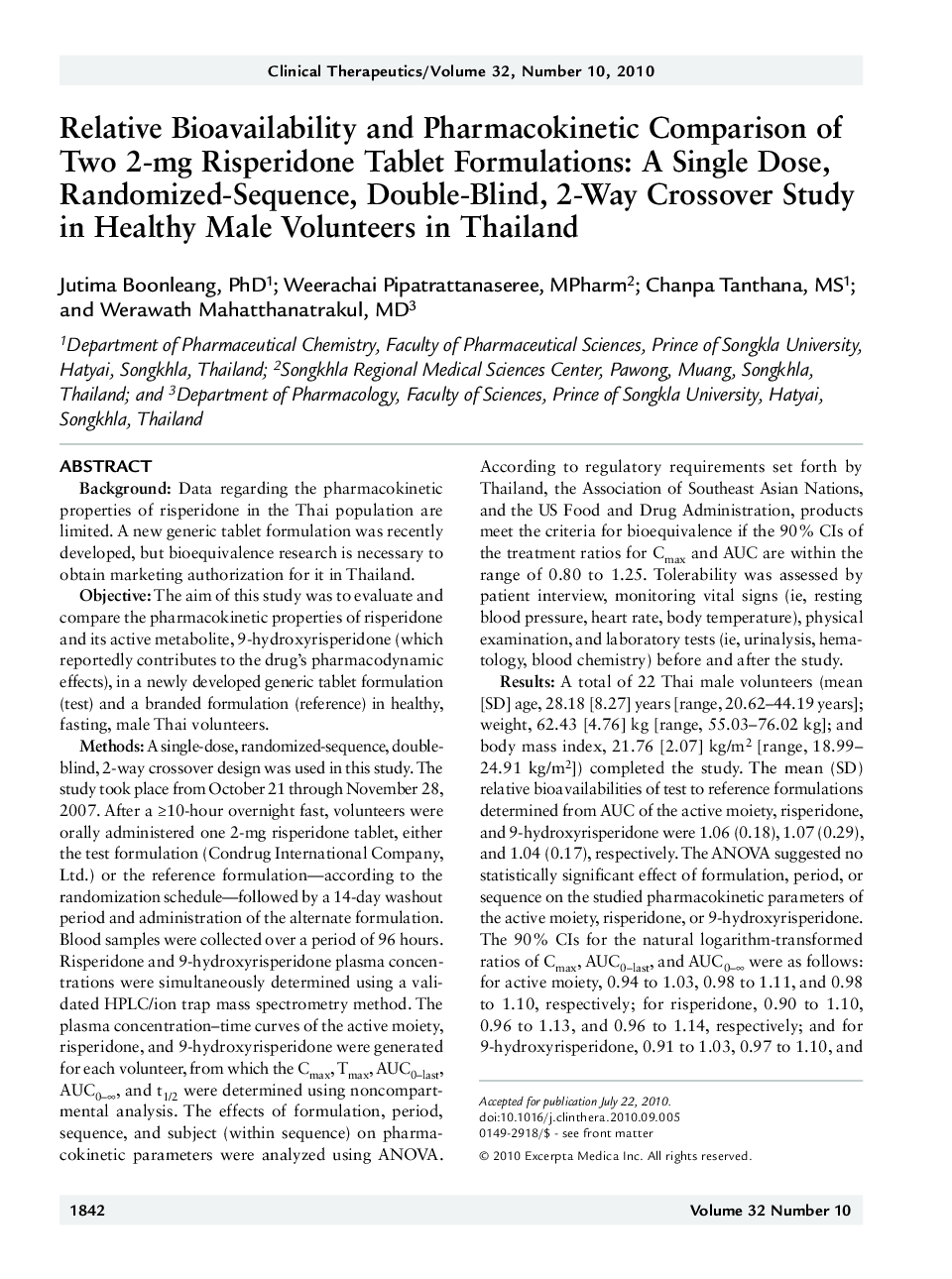| کد مقاله | کد نشریه | سال انتشار | مقاله انگلیسی | نسخه تمام متن |
|---|---|---|---|---|
| 2528670 | 1119980 | 2010 | 12 صفحه PDF | دانلود رایگان |

Background: Data regarding the pharmacokinetic properties of risperidone in the Thai population are limited. A new generic tablet formulation was recently developed, but bioequivalence research is necessary to obtain marketing authorization for it in Thailand.Objective: The aim of this study was to evaluate and compare the pharmacokinetic properties of risperidone and its active metabolite, 9-hydroxyrisperidone (which reportedly contributes to the drug's pharmacodynamic effects), in a newly developed generic tablet formulation (test) and a branded formulation (reference) in healthy, fasting, male Thai volunteers.Methods: A single-dose, randomized-sequence, doubleblind, 2-way crossover design was used in this study. The study took place from October 21 through November 28, 2007. After a ≥10-hour overnight fast, volunteers were orally administered one 2-mg risperidone tablet, either the test formulation (Condrug International Company, Ltd.) or the reference formulation—according to the randomization schedule—followed by a 14-day washout period and administration of the alternate formulation. Blood samples were collected over a period of 96 hours. Risperidone and 9-hydroxyrisperidone plasma concentrations were simultaneously determined using a validated HPLC/ion trap mass spectrometry method. The plasma concentration-time curves of the active moiety, risperidone, and 9-hydroxyrisperidone were generated for each volunteer, from which the Cmax, Tmax, AUC0-last, AUC0-∞, and t½ were determined using noncompart-mental analysis. The effects of formulation, period, sequence, and subject (within sequence) on pharmacokinetic parameters were analyzed using ANOVA. According to regulatory requirements set forth by Thailand, the Association of Southeast Asian Nations, and the US Food and Drug Administration, products meet the criteria for bioequivalence if the 90% CIs of the treatment ratios for Cmax and AUC are within the range of 0.80 to 1.25. Tolerability was assessed by patient interview, monitoring vital signs (ie, resting blood pressure, heart rate, body temperature), physical examination, and laboratory tests (ie, urinalysis, hematology, blood chemistry) before and after the study.Results: A total of 22 Thai male volunteers (mean [SD] age, 28.18 [8.27] years [range, 20.62–44.19 years]; weight, 62.43 [4.76] kg [range, 55.03–76.02 kg]; and body mass index, 21.76 [2.07] kg/m2 [range, 18.9924.91 kg/m2]) completed the study. The mean (SD) relative bioavailabilities of test to reference formulations determined from AUC of the active moiety, risperidone, and 9-hydroxyrisperidone were 1.06 (0.18), 1.07 (0.29), and 1.04 (0.17), respectively. The ANOVA suggested no statistically significant effect of formulation, period, or sequence on the studied pharmacokinetic parameters of the active moiety, risperidone, or 9-hydroxyrisperidone. The 90% CIs for the natural logarithm-transformed ratios of Cmax, AUC0-last, and AUC0-∞ were as follows: for active moiety, 0.94 to 1.03, 0.98 to 1.11, and 0.98 to 1.10, respectively; for risperidone, 0.90 to 1.10, 0.96 to 1.13, and 0.96 to 1.14, respectively; and for 9-hydroxyrisperidone, 0.91 to 1.03, 0.97 to 1.10, and 0.96 to 1.09, respectively. All met the criteria for bioequivalence. The most commonly reported adverse events (AEs) were somnolence (100.0%), orthostatic hypotension (13.6%), headache (4.5%), and syncope (2.3%). AEs were mild and disappeared within 1 day. No volunteers withdrew from the study because of AEs.Conclusions: The single-dose pharmacokinetic data in this small, all-male, selected sample of fasting, healthy volunteers met Thailand's regulatory criteria for assuming bioequivalence of the tested generic and reference 2-mg risperidone tablets. Both formulations were well tolerated.
Journal: Clinical Therapeutics - Volume 32, Issue 10, September 2010, Pages 1842-1853